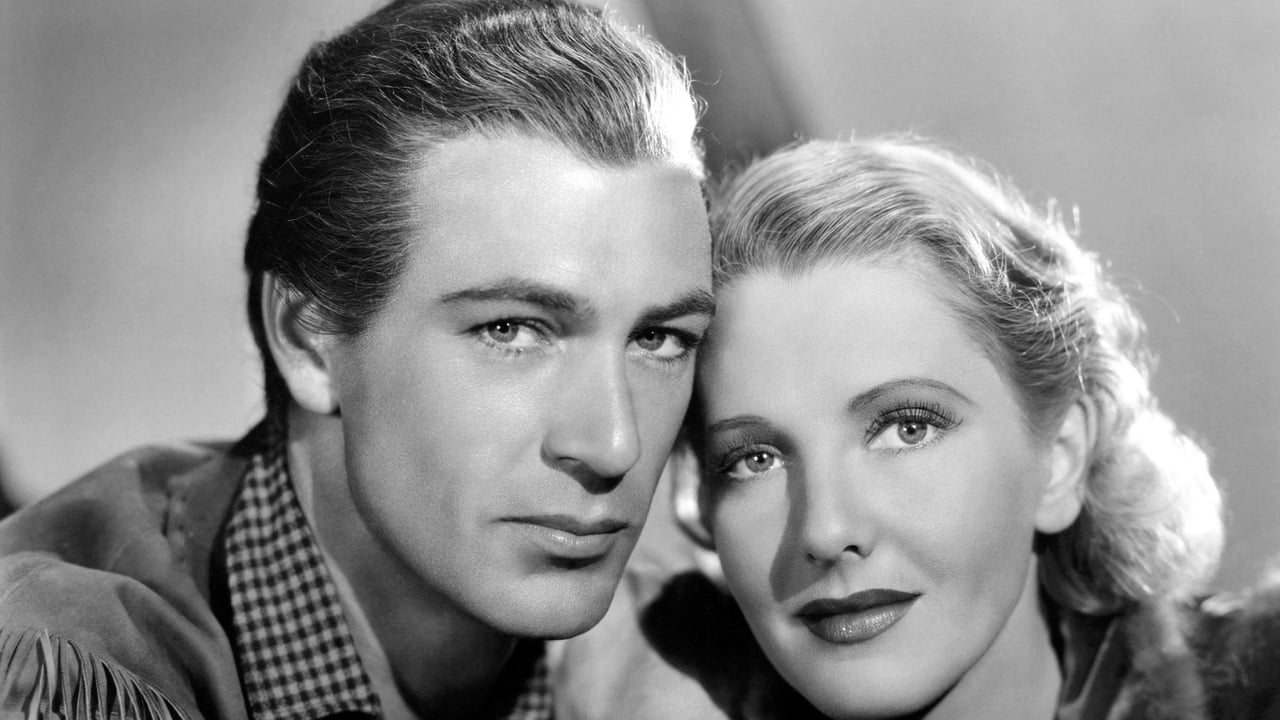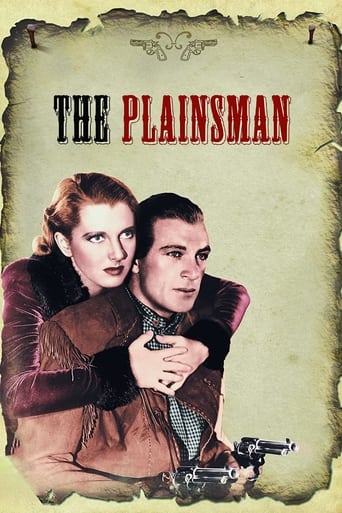

"Cecil B. DeMille Much against his will Was persuaded to leave Moses Out of the Wars of the Roses". Unlike some clerihews, that one encapsulates an essential truth about its subject. Most of DeMille's films were set in some period of history, but he was not a stickler for historical accuracy and never let inconvenient facts get in the way of a good story. DeMille is best remembered today for grand epics like "The Ten Commandments", but he also made a number of Westerns, of which "The Plainsman" is one. He saw the Old West as one more canvas on which he could paint an epic tale of heroism and adventure, and felt no more need for accuracy when dealing with American history than when dealing with the ancient world. The film is set between the end of the American Civil War and Custer's Last Stand, in reality a period of eleven years but here seeming like only a few weeks or months. The main characters are Wild Bill Hickok, Calamity Jane, Buffalo Bill Cody, and General Custer, although the account of their lives is highly fictionalised. I am only surprised that DeMille did not try and introduce Jesse James, Wyatt Earp, Billy the Kid and Annie Oakley into the mix, thereby getting all the main Western heroes into the same film. Knowing him he could probably have got Hopalong Cassidy and the Lone Ranger in there as well. The main villain is a gun-runner named Lattimer who is selling rifles to the Cheyenne Indians. He is acting as agent for a group of unscrupulous weapon manufacturers whose business has taken a hit with the end of the Civil War and who view the Indians not as enemies of the United States but as potential new customers. The film tells the story of how our four heroes frustrate this dastardly plot and ensure that the rifles find their way to the Cavalry. There is also a subplot about the romance between Hickok and Calamity. As that synopsis might suggest, this is not one of those revisionist Westerns which try to tell the story of the West from a viewpoint sympathetic to the Indians, or even one which tries to tell it from a viewpoint even-handed between Indians and whites. The concept of the "revisionist Western" did not really exist in 1936. Modern audiences might have a certain sneaking sympathy with Lattimer whose endeavours, however mercenary his motives, do at least have the effect of partially levelling an otherwise very uneven playing-field between Indians and whites. In the thirties, however, it was still "white man good, red man bloodthirsty savage". Only in one scene, when the Cheyenne chieftain Yellow Hand is allowed to state his point of view, is it suggested that the Indian Wars might have had more to do with white greed than with red bloodlust.Despite its dodgy political stance, "The Plainsman" is by no means a bad film. During a decade when many directors turned to intimate, small- scale movies, DeMille remained true to the sort of large-scale action films with which he made his name in the silent era. "The Plainsman" is not quite as spectacular as some Westerns from the fifties and sixties, but it has some good action sequences, especially the Indian attack on the ammunition train and the subsequent siege. Gary Cooper as Hickok makes a charismatic hero- he has a rather larger role than James Ellison as Cody or John Miljan as Custer- and Jean Arthur as Calamity is better than her successors in the same role, Jane Russell in "The Paleface" (too glamorous) and Doris Day in "Calamity Jane" (so obviously unsuitable that I can only assume this was deliberate miscasting for comic effect). Anthony Quinn (DeMille's son-in-law) has small early role as an Indian. Today we lovers of the Western are lucky in that we have available to us so many films by the masters of the genre such as John Ford, John Huston, George Stevens, Anthony Mann, William Wyler and Clint Eastwood. People in 1936 were not so lucky. Certainly, "poverty row" Westerns were ten-a-penny in the thirties, but few of these were of any quality, even when they featured stars of the future like John Wayne. Even the likes of "Destry Rides Again", "Dodge City" and "Stagecoach" still lay a couple of years in the future. A major-league Western by a major-league director like DeMille was therefore something of a novelty at the time. "The Plainsman" is not in the same league as the greatest works of the directors mentioned above, but it is a very decent Western for the mid- thirties. 7/10 Some goofs. In a scene set in the 1860s there is a reference to tumbleweed. Although these plants have come to be regarded as iconic symbols of the West, they are actually native to Asia and were not introduced to North America until after the events depicted in this film. ("The Plainsman", however, is far from the only film to make this mistake). Calamity Jane pronounces her surname, Canary, as though it were the name of the bird; in reality it was pronounced, and sometimes spelt, "Cannary", with the stress on the first syllable.
... View MoreThere were not a lot of Westerns in the 1930s, at least not in the A-budget bracket. So why would that canny marketeer and bandwagon-hopper Cecil B. DeMille decide to make one in 1936? The answer is simple. After the failure of his few dramas in the early talkie period, he vowed to make only "big" pictures, and the Old West was simply another historical arena for grand heroic exploits, just like the crusades or the high seas.This being DeMille, the idea seems to have been to do a kind of definitive take on the setting. Waldemar Young and Harold Lamb, DeMille's current hacks-du-jour, along with "Oklahoma" playwright Lynn Riggs have created a screenplay that is not so much a cliché-fest as a cosy, sanitised and highly anachronistic snapshot of Western mythology. So we get Wild Bill Hickok, Calamity Jane, Buffalo Bill and General Custer all cheerfully rubbing shoulders like an Old West version of The League of Extraordinary Gentlemen, and banding together against the common enemy (the injuns, of course). DeMille's penchant for historical accuracy may give the sets and costumes a look of authenticity, but does not extend as far as actually portraying Calamity as a drunken prostitute, and Hickok as a kind of 19th-century Lemmy from Motorhead.The two leads may not look like their historical counterparts, but at least Gary Cooper and Jean Arthur have the rugged demeanour of frontierspeople. They are also good enough performers to do a decent job despite a lack of coaching from DeMille. But as is often the case, the most interesting players are the villains. Charles Bickford looks as if he was chiselled from the buttes of the plains themselves, and gives a performance comparable to Walter Huston's Trampas in the 1929 version of The Virginian. Victor Varconi, once a handsome lead man in the silents, now thanks to his accent and looks reduced to playing all manner of swarthy baddies, is compellingly menacing as Painted Horse. And finally a young Anthony Quinn makes a short but impressive appearance as a Cheyenne warrior, lending a degree of dignity to the natives that is woefully absent in the rest of the picture.DeMille himself though does not appear to have "got" the genre. Despite the title, we don't really get to see those plains, and there is none of the romance of the outdoor lifestyle that makes classic Westerns what they are. But looking at DeMille's style you can see he is not a fan of empty spaces. Bigness for him means fullness. He really goes to town on the steamboat boarding scene, conjuring up an image of lively bustle with people moving across the frame in layers receding in depth. This is a very effective way of making a place look crowded without having to place the camera too far back or hire out every extra on the books. In other scenes, such as the one where the townspeople threaten to tar and feather Jean Arthur he uses extras to build walls around the action, filling every spare space with people. Even in simpler scenes there tends to be a degree of complexity to the shot, like a classical painting that tries to cram every aspect of an idea onto the canvas. And DeMille's images are often beautiful in a painterly way, but still the lack of "west" on display stops this from feeling like a Western.Think of this then more as an adventure yarn than a horse opera. It may be silly as silly can be (my favourite daft moment is in the opening scene, when Abe Lincoln's wife bursts into a meeting to remind him he's going to be late for the theatre, followed by a doom-laden chord in the background score), but it is not bad as far as no-brainer entertainment goes. The action scenes are exciting and punchy, largely thanks to the dynamic editing of Anne Bauchens. This is by no means essential DeMille, and certainly not essential Cooper, but is good fun if you happen to catch it.
... View MoreWild Bill Hickock, Buffalo Bill Cody, and Calamity Jane fight alongside General Custer and expose a scheme by greedy arms manufacturers to sell repeating rifles to renegade Indians.This somewhat gratuitous exercise in wild west name-dropping is pretty silly but also fairly entertaining as well, though it's a bit too long and runs out of steam near the end.Also, it might be off-putting to many modern viewers due to it's politically incorrect, stereotyped treatment of Indians.The feisty Jean Arthur is extremely cute as Calamity Jane and easily runs away with the picture.Recognizable cameos include iconic western sidekick George "Gabby" Hayes as a wounded scout and director Cecile B. DeMille's future son-in-law Anthony Quinn as the Cheyenne brave who relates the news of Custer's last stand to Cody and Hickock.
... View MoreWith the end of the North American Civil War, the manufacturers of repeating rifles find a profitable means of making money selling the weapons to the North American Indians, using the front man John Lattimer (Charles Bickford) to sell the rifles to the Cheyenne. While traveling in a stagecoach with Calamity Jane (Jean Arthur) and William "Buffalo Bill" Cody (James Ellison) and his young wife Louisa Cody (Helen Burgess) that want to settle down in Hays City managing a hotel, Wild Bill Hickok (Gary Cooper) finds the guide Breezy (George Hayes) wounded by arrows and telling that the Indians are attacking a fort using repeating rifles. Hickok meets Gen. George A. Custer (John Miljan) that assigns Buffalo Bill to guide a troop with ammunition to help the fort. Meanwhile the Cheyenne kidnap Calamity Jane, forcing Hickok to expose himself to rescue her.The dated "The Plainsman" is a great deception, with a pretentious and shallow story without historical accuracy, "politically incorrect" in the present days and a terrible screenplay that wastes Gary Cooper and Jean Arthur. Their performances are below average with awful characters. The best part is the beginning, with the inception of the lobby of the greedy manufacturers of weapons using the repeating rifles to provide Indian (and also "white man") annihilation in the name of the pockets full of money. My vote is five.Title (Brazil): "Jornadas Heróicas" ("Heroic Journeys")
... View More